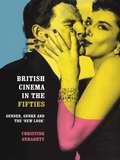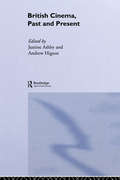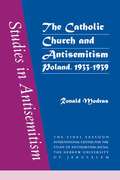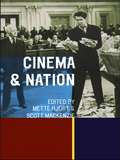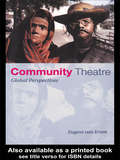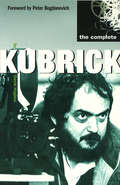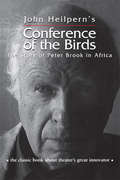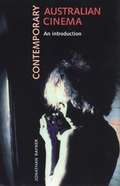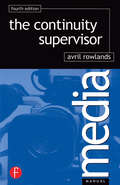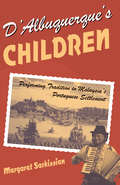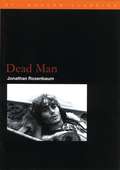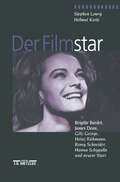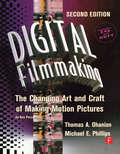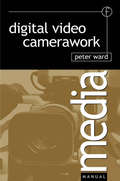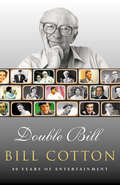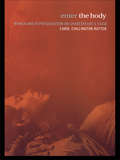- Table View
- List View
British Cinema in the Fifties: Gender, Genre and the 'New Look'
by Christine GeraghtyIn the fifties British cinema won large audiences with popular war films and comedies, creating stars such as Dirk Bogarde and Kay Kendall, and introducing the stereotypes of war hero, boffin and comic bureaucrat which still help to define images of British national identity. In British Cinema in the Fifties, Christine Geraghty examines some of the most popular films of this period, exploring the ways in which they approached contemporary social issues such as national identity, the end of empire, new gender roles and the care of children.Through a series of case studies on films as diverse as It Always Rains on Sunday and Genevieve, Simba and The Wrong Arm of the Law, Geraghty explores some of the key debates about British cinema and film theory, contesting current emphases on contradiction, subversion and excess and exploring the curious mix of rebellion and conformity which marked British cinema in the post-war era.
British Cinema, Past and Present
by Justine Ashby Andrew HigsonBritish Cinema: Past and Present responds to the commercial and critical success of British film in the 1990s. Providing a historical perspective to the contemporary resurgence of British cinema, this unique anthology brings together leading international scholars to investigate the rich diversity of British film production, from the early sound period of the 1930s to the present day.The contributors address:* British Cinema Studies and the concept of national cinema* the distribution and reception of British films in the US and Europe* key genres, movements and cycles of British cinema in the 1940s, 50s and 60s* questions of authorship and agency, with case studies of individual studios, stars, producers and directors* trends in British cinema, from propaganda films of the Second World War to the New Wave and the 'Swinging London' films of the Sixties* the representation of marginalised communities in films such as Trainspotting and The Full Monty* the evolution of social realism from Saturday Night, Sunday Morning to Nil By Mouth* changing approaches to Northern Ireland and the Troubles in films like The Long Good Friday and Alan Clarke's Elephant* contemporary 'art' and 'quality' cinema, from heritage drama to the work of Peter Greenaway, Derek Jarman, Terence Davies and Patrick Keiller.
British Cinema, Past and Present
by Justine Ashby Andrew HigsonBritish Cinema: Past and Present responds to the commercial and critical success of British film in the 1990s. Providing a historical perspective to the contemporary resurgence of British cinema, this unique anthology brings together leading international scholars to investigate the rich diversity of British film production, from the early sound period of the 1930s to the present day.The contributors address:* British Cinema Studies and the concept of national cinema* the distribution and reception of British films in the US and Europe* key genres, movements and cycles of British cinema in the 1940s, 50s and 60s* questions of authorship and agency, with case studies of individual studios, stars, producers and directors* trends in British cinema, from propaganda films of the Second World War to the New Wave and the 'Swinging London' films of the Sixties* the representation of marginalised communities in films such as Trainspotting and The Full Monty* the evolution of social realism from Saturday Night, Sunday Morning to Nil By Mouth* changing approaches to Northern Ireland and the Troubles in films like The Long Good Friday and Alan Clarke's Elephant* contemporary 'art' and 'quality' cinema, from heritage drama to the work of Peter Greenaway, Derek Jarman, Terence Davies and Patrick Keiller.
The Catholic Church and Antisemitism
by Ronald ModrasInterwar Poland was home to more Jews than any other country in Europe. Its commonplace but simplistic identification with antisemitism was due largely to nationalist efforts to boycott Jewish business. That they failed was not for want of support by the Catholic clergy, for whom the ''Jewish question'' was more than economic. The myth of a Masonic-Jewish alliance to subvert Christian culture first flourished in France but held considerable sway over Catholics in 1930s Poland as elsewhere. This book examines how, following Vatican policy, Polish church leaders resisted separation of church and state in the name of Catholic culture. In that struggle, every assimilated Jew served as both a symbol and a potential agent of security. Antisemitism is no longer regarded as a legitimate political stance. But in Europe, the United States, and the Middle East, the issues of religious culture, national identity, and minorities are with us still. This study of interwar Poland will shed light on dilemmas that still effect us today.
The Catholic Church and Antisemitism
by Ronald ModrasInterwar Poland was home to more Jews than any other country in Europe. Its commonplace but simplistic identification with antisemitism was due largely to nationalist efforts to boycott Jewish business. That they failed was not for want of support by the Catholic clergy, for whom the ''Jewish question'' was more than economic. The myth of a Masonic-Jewish alliance to subvert Christian culture first flourished in France but held considerable sway over Catholics in 1930s Poland as elsewhere. This book examines how, following Vatican policy, Polish church leaders resisted separation of church and state in the name of Catholic culture. In that struggle, every assimilated Jew served as both a symbol and a potential agent of security. Antisemitism is no longer regarded as a legitimate political stance. But in Europe, the United States, and the Middle East, the issues of religious culture, national identity, and minorities are with us still. This study of interwar Poland will shed light on dilemmas that still effect us today.
Cinema and Nation
by Mette Hjort Scott MackenzieIdeas of national identity, nationalism and transnationalism are now a central feature of contemporary film studies, as well as primary concerns for film-makers themselves. Embracing a range of national cinemas including Scotland, Poland, France, Turkey, Indonesia, India, Germany and America, Cinema and Nation considers the ways in which film production and reception are shaped by ideas of national belonging and examines the implications of globalisation for the concept of national cinema.In the first three Parts, contributors explore sociological approaches to nationalism, challenge the established definitions of 'national cinema', and consider the ways in which states - from the old Soviet Union to contemporary Scotland - aim to create a national culture through cinema. The final two Parts address the diverse strategies involved in the production of national cinema and consider how images of the nation are used and understood by audiences both at home and abroad.
Cinema and Nation
by Mette Hjort Scott MacKenzieIdeas of national identity, nationalism and transnationalism are now a central feature of contemporary film studies, as well as primary concerns for film-makers themselves. Embracing a range of national cinemas including Scotland, Poland, France, Turkey, Indonesia, India, Germany and America, Cinema and Nation considers the ways in which film production and reception are shaped by ideas of national belonging and examines the implications of globalisation for the concept of national cinema.In the first three Parts, contributors explore sociological approaches to nationalism, challenge the established definitions of 'national cinema', and consider the ways in which states - from the old Soviet Union to contemporary Scotland - aim to create a national culture through cinema. The final two Parts address the diverse strategies involved in the production of national cinema and consider how images of the nation are used and understood by audiences both at home and abroad.
Community Theatre: Global Perspectives
by Eugene van ErvenCommunity theatre is an important device for communities to collectively share stories, to participate in political dialogue, and to break down the increasing exclusion of marginalised groups of citizens. It is practised all over the world by growing numbers of people. Published at the same time as a video of the same name, this is a unique record of these theatre groups in action. Based on van Erven's own travels and experiences working with community theatre groups in six very different countries, this is the first study of their work and the methodological traditions which have developed around the world.
Community Theatre: Global Perspectives
by Eugene van ErvenCommunity theatre is an important device for communities to collectively share stories, to participate in political dialogue, and to break down the increasing exclusion of marginalised groups of citizens. It is practised all over the world by growing numbers of people. Published at the same time as a video of the same name, this is a unique record of these theatre groups in action. Based on van Erven's own travels and experiences working with community theatre groups in six very different countries, this is the first study of their work and the methodological traditions which have developed around the world.
The Complete Kubrick
by David HughesWith just thirteen feature films in half a century, Stanley Kubrick established himself as one of the most accomplished directors in motion picture history. Kubrick created a landmark and a benchmark with every film; working in almost every genre imaginable, including film noir, war movie, SF, horror, period drama, historical epic, love story and satire - yet transcended traditional genre boundaries with every shot. Examining every feature film, from the early shorts through to classics such as Paths of Glory, Dr Strangelove, 2001: A Space Odyssey, A Clockwork Orange, The Shining, Full Metal Jacket and finally, Eyes Wide Shut, The Complete Kubrick provides a unique insight into understanding the work of cinema's most enigmatic, iconoclastic and gifted auteur.
Conference of the Birds: The Story of Peter Brook in Africa
by John HeilpernConference of the Birds is John Heilpern's true story of an extraordinary journey. In December 1972, the director Peter Brook and an international troupe of actors (Helen Mirren and Yoshi Oida among them) left their Paris base to emerge again in the Sahara desert. It was the start of an 8,500-mile expedition through Africa without precedent in the history of theater. Brook was in search of a new beginning that has since been revealed in all his work--from Conference of the Birds and Carmen to The Mahabharata and beyond. At the heart of John Heilpern's brilliant account of the African experiment is a story that became a search for the miraculous.
Conference of the Birds: The Story of Peter Brook in Africa
by John HeilpernConference of the Birds is John Heilpern's true story of an extraordinary journey. In December 1972, the director Peter Brook and an international troupe of actors (Helen Mirren and Yoshi Oida among them) left their Paris base to emerge again in the Sahara desert. It was the start of an 8,500-mile expedition through Africa without precedent in the history of theater. Brook was in search of a new beginning that has since been revealed in all his work--from Conference of the Birds and Carmen to The Mahabharata and beyond. At the heart of John Heilpern's brilliant account of the African experiment is a story that became a search for the miraculous.
Contemporary Australian cinema: An introduction
by Jonathan RaynerProvides an introduction to the products and context of the new Australian film industry which arose toward the end of the 1960s. Traces the development of Australian film, in terms of prominent directors and stars, consistent themes, styles and evolving genres. The evolution of the film genres peculiar to Australia, and the adaptation of conventional Hollywood forms (such as the musical and the road movie) are examined in detail through textual readings of landmark films. Films and trends discussed include: the period film and Picnic at Hanging Rock; the Gothic film and the Mad Max trilogy; camp and kitsch comedy and the Adventures of Pricilla, Queen of the Desert. The key issue of the revival (the definition, representation and propagation of a national image) is woven through analysis of the new Australian cinema.
Continuity Supervisor
by Avril RowlandsThe Continuity Supervisor is a practical guide to the basics of continuity, designed to be of use both to the newcomer and those more experienced. Formerly titled 'The Continuity Handbook: a guide for single-camera shooting, this new edition covers the latest technological changes which affect the Continuity Supervisor. Avril Rowlands worked at the BBC for any years as a PA. She has been involved in specialised training for the television industry and major film and television colleges. Her highly acclaimed residential courses attract students from major television companies worldwide. She is also a writer and independent television producer.
Continuity Supervisor
by Avril RowlandsThe Continuity Supervisor is a practical guide to the basics of continuity, designed to be of use both to the newcomer and those more experienced. Formerly titled 'The Continuity Handbook: a guide for single-camera shooting, this new edition covers the latest technological changes which affect the Continuity Supervisor. Avril Rowlands worked at the BBC for any years as a PA. She has been involved in specialised training for the television industry and major film and television colleges. Her highly acclaimed residential courses attract students from major television companies worldwide. She is also a writer and independent television producer.
D'Albuquerque's Children: Performing Tradition in Malaysia's Portuguese Settlement (Chicago Studies in Ethnomusicology)
by Margaret SarkissianWhen the Portuguese seafarer Afonso de Albuquerque conquered the bustling port of Malacca in 1511, he effectively gained control of the entire South China Sea spice trade. Although their dominance lasted only 130 years, the Portuguese legacy lies at the heart of a burgeoning tourist attraction on the outskirts of the city, in which performers who believe they are the descendants of swashbuckling Portuguese conquerors encapsulate their "history" in a cultural stage show. Using historical and ethnographic data, Margaret Sarkissian reveals that this music and dance draws on an eclectic array of influences that span the Portuguese diaspora (one song conjures up images of Lucille Ball impersonating Carmen Miranda on "I Love Lucy"). Ironically, she shows, what began as a literate tradition in the 1950s has now become an oral one so deeply rooted in Settlement life that the younger generation, like the tourists, now see it as an unbroken heritage stretching back almost 500 years. A fascinating case of "orientalism in reverse," D'Albuquerque's Children illuminates the creative ways in which one community has adapted to life in a postcolonial world.
Dead Man (BFI Film Classics)
by Jonathan RosenbaumWhen it was released in 1995, Dead Man puzzled many audiences and critics. Jim Jarmusch's reputation was for directing slick, hip contemporary films. And Dead Man was a black-and-white Western. As time has passed, though, the number of its admirers has grown rapidly. Indeed Dead Man, with its dark and unconventional treatment of violence, racism and capitalism, may be Jarmusch's finest work to date.This is Jonathan Rosenbaum's view. For him, Dead Man is both a quantum leap and a logical next step in Jarmusch's career. Starring Johnny Depp as the uprooted accountant William Blake and Gary Farmer as his enigmatic Native American companion, Nobody, and with startling cameos from Robert Mitchum, John Hurt and Iggy Pop, Dead Man is by turns shocking, comic and deeply moving. This book explorers and celebrates a masterpiece of 1990s American cinema.
Der Filmstar: Brigitte Bardot, James Dean, Götz George, Heinz Rühmann, Romy Schneider, Hanna Schygulla und neuere Stars
by Helmut Korte Stephen LowryFilmstars gehören zu den bekanntesten öffentlichen Personen des 20. Jahrhunderts. In exemplarischen Untersuchungen zu Stars wie Brigitte Bardot, James Dean, Götz George und Heinz Rühmann, stellt die tiefgründige Analyse die wesentlichen filmischen, kulturellen und historischen Aspekte des Starphänomens dar. Weitere Kapitel legen die Grundlagen für eine Theorie des Filmstars und diskutieren die aktuellen Entwicklungen im Starkino der 90er Jahre.
Digital Filmmaking: The Changing Art and Craft of Making Motion Pictures
by Thomas Ohanian Natalie PhillipsDigital Filmmaking has been called the bible for professional filmmakers in the digital age. It details all of the procedural, creative, and technical aspects of pre-production, production, and post-production within a digital filmmaking environment. It examines the new digital methods and techniques that are redefining the filmmaking process, and how the evolution into digital filmmaking can be used to achieve greater creative flexibility as well as cost and time savings. The second edition includes updates and new information, including four new chapters that examine key topics like digital television and high definition television,making films using digital video, 24 P and universal mastering, and digital film projection. Digital Filmmaking provides a clear overview of the traditional filmmaking process, then goes on to illuminate the ways in which new methods can accomplish old tasks. It explains vital concepts, including digitization, compression, digital compositing, nonlinear editing, and on-set digital production and relates traditional film production and editing processes to those of digital techniques. Various filmmakers discuss their use of digital techniques to enhance the creative process in the "Industry Viewpoints" sections in each chapter .
Digital Filmmaking: The Changing Art and Craft of Making Motion Pictures
by Thomas Ohanian Natalie PhillipsDigital Filmmaking has been called the bible for professional filmmakers in the digital age. It details all of the procedural, creative, and technical aspects of pre-production, production, and post-production within a digital filmmaking environment. It examines the new digital methods and techniques that are redefining the filmmaking process, and how the evolution into digital filmmaking can be used to achieve greater creative flexibility as well as cost and time savings. The second edition includes updates and new information, including four new chapters that examine key topics like digital television and high definition television,making films using digital video, 24 P and universal mastering, and digital film projection. Digital Filmmaking provides a clear overview of the traditional filmmaking process, then goes on to illuminate the ways in which new methods can accomplish old tasks. It explains vital concepts, including digitization, compression, digital compositing, nonlinear editing, and on-set digital production and relates traditional film production and editing processes to those of digital techniques. Various filmmakers discuss their use of digital techniques to enhance the creative process in the "Industry Viewpoints" sections in each chapter .
Digital Video Camerawork (Media Manuals Ser.)
by Peter WardThis manual introduces digital camerawork techniques used in television and video production. Written as a practical guide, the author's step-by-step instructions take you through everything you need to know, from camera controls, to editing, lighting and sound. This text provides a solid foundation to build upon in the area of digital video production. In a period of transition between analogue and digital acquisition/recording formats Digital Video Camerawork provides up-to-date information familiarizing you with the different production styles and requirements. Diagrams are used to illustrate the technology and techniques explained.Digital Video Camerawork combines clear, technical explanations with practical advice. It is ideal for the less experienced broadcast camera operator and for students on media and television production courses.
Digital Video Camerawork
by Peter WardThis manual introduces digital camerawork techniques used in television and video production. Written as a practical guide, the author's step-by-step instructions take you through everything you need to know, from camera controls, to editing, lighting and sound. This text provides a solid foundation to build upon in the area of digital video production. In a period of transition between analogue and digital acquisition/recording formats Digital Video Camerawork provides up-to-date information familiarizing you with the different production styles and requirements. Diagrams are used to illustrate the technology and techniques explained.Digital Video Camerawork combines clear, technical explanations with practical advice. It is ideal for the less experienced broadcast camera operator and for students on media and television production courses.
Double Bill (Text Only): 80 Years Of Entertainment
by Bill CottonPacked with anecdotes, sparkling insights into the changing nature of show business and the turbulent world of the BBC, and boasting a glittering cast-list, Double Bill is a fascinating read, unashamedly nostalgic and often hilarious.
Enter The Body: Women and Representation on Shakespeare's Stage
by Carol Chillington RutterEnter the Body offers a series of provocative case studies of the work women's bodies do on Shakespeare's intensely body-conscious stage. Rutter's topics are sex, death, race, gender, culture, politics, and the excessive performative body that exceeds the playtext it inhabits. As well as drawing upon vital primary documents from Shakespeare's day, Rutter offers close readings of women's performance's on stage and film in Britian today, from Peggy Ashcroft's (white) Cleopatra and Whoopi Goldberg's (whiteface) African Queen to Sally Dexter's languorous Helen and Alan Howard's raver 'Queen' of Troy.
Enter The Body: Women and Representation on Shakespeare's Stage
by Carol Chillington RutterEnter the Body offers a series of provocative case studies of the work women's bodies do on Shakespeare's intensely body-conscious stage. Rutter's topics are sex, death, race, gender, culture, politics, and the excessive performative body that exceeds the playtext it inhabits. As well as drawing upon vital primary documents from Shakespeare's day, Rutter offers close readings of women's performance's on stage and film in Britian today, from Peggy Ashcroft's (white) Cleopatra and Whoopi Goldberg's (whiteface) African Queen to Sally Dexter's languorous Helen and Alan Howard's raver 'Queen' of Troy.
